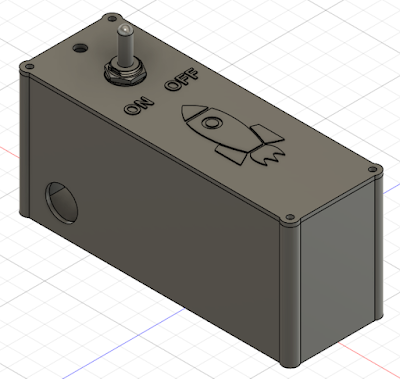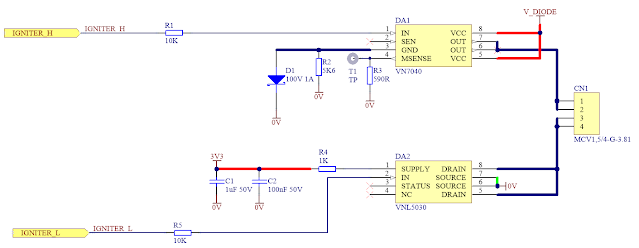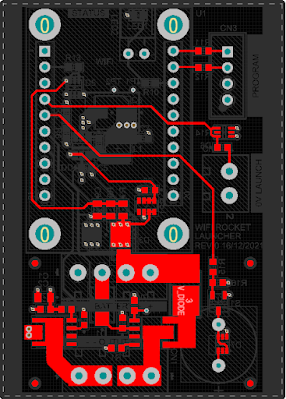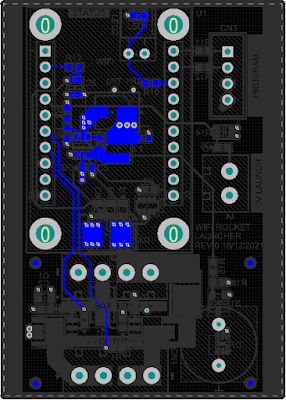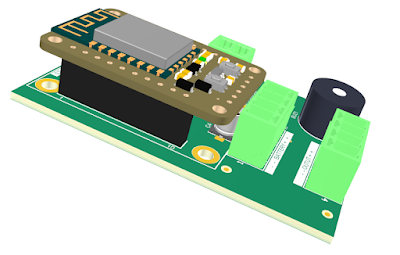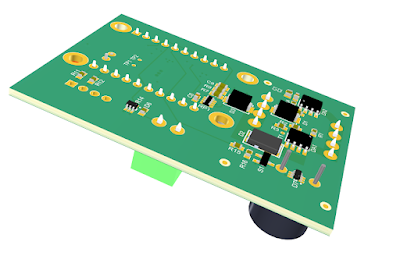Summary
Illustrated in this blog are
modifications to the prototype Bluetooth Model Rocket Launcher (Launcher)
carrier Circuit Board (PCB) with a view to manufacturing. This blog uses a prototype board to
highlight facets such as design simplification, reduction in dissimilar
components, part consolidation through schematic changes and reduction in the
PCB area.
 |
| Updated Launcher PCB 3D |
This blog does not cover cost reductions aspects
such as integrating the Cypress Bluetooth Module
into the carrier PCB or reducing the board layer geometry.
Reducing Component Count
Reducing or removing
electronic components from a design is an initial step which should be
undertaken when reviewing a board design for Production. Performing this step after
the subsequent part consolidation step may result in the repetition of one or more steps although, the review should be made on a design basis.
UHF
Receiver
The Launcher was initially designed with a UHF receiver option for backwards
compatibility. Since the Bluetooth functionality was tested in a previous blog,
the UHF receiver was removed from the design.
 |
| Legacy UHF Receiver RX3302D |
 |
| Legacy UHF Receiver RX3302D on Launcher PCB |
Alternate Current Sensing Option
For higher current sensing accuracy of the igniter, a TI Current Sensor INA219 was included in the design but not
used. As the accuracy was not required and current monitoring was achieved through
the ST part VN7040, the INA219 was removed.
 |
| Launcher INA219 |
Feature Resistors
For the Launcher design, optional resistors were included on the board for controlling features and options in firmware however these resistors were not used. |
| Launcher Feature Resistors |
It was decided to remove half of the
resistors from the PCB. The remaining resistors were replaced with PCB pads/jumpers. These pads are bridged with solder
to enable or disable the option.
 |
| Launcher Alternate Feature Selection |
Component
Consolidation
Part or component consolidation
intends to reduce the number of different parts used in the design. For a
Production environment, reducing the number of different components may assist the
board loader with aspects such as stock availability and stock holding. Some part
consolidation may physically not be practical or may lead to a detrimental change
in the performance of the circuit design. Products with multiple variants, special builds or concessions should all be singularly reviewed at
the same time. As with any design, all changes
should be reviewed and qualified.
To review parts and quantities in the Launcher design, the Bill of Materials (BOM) was reviewed.
Shown below is an extract of the BOM from the Launcher project.
 |
| Launcher Bill of Materials |
Power
Supply
The switch-mode power
supply could be changed to a linear regulator. Even though a linear
regulator would be a simpler and cheaper option, the switch-mode is more
efficient and considered an improvement to the design.
Shutdown
Pin
For the switch-mode controller, some components could be consolidated. The
Shutdown pin originally used a 10 k and 2.2 k resistor.
For the Rocket
Launcher, removal of the current sensor meant that few 2.2 k resistors were
used in the design.
 |
Launcher Updated PSU Shutdown Circuit
|
Changing the 2.2 k resistor
on the Shutdown pin to 5.6 k consolidated the parts and raised the shutdown
voltage to a more suitable level.
Switching
Diode
The Rocket Launcher
used multiple Schottky Diodes which had forward current ratings of 1 A. One
diode’s reverse voltage was 40 V and the second 100 V. Either diode would be
more than adequate for this design.
Reviewing the characteristics, price and
availability of the diodes, the 100 V part was selected to replace the other diodes.
 |
| Launcher Updated PSU Diode |
Input
Diode
The input diode was another
1 A Schottky diode with a higher reverse voltage. This was replaced with the 1
A 100 V Schottky diode. |
| Launcher Updated PSU Input Diode |
Battery
Voltage Divider
The battery voltage divider
was achieved using a 10 k and a 2.2 k resistor in the original design.
For common components, the
resistor values were changed to 5.6 k and 1 k. This change would result in adjustments
to the ADC however, this was considered trivial.
 |
| Launcher Updated Voltage Divider |
Buzzer
Diode
The flyback diode for
the buzzer was omitted in the original design however one of the larger Schottky
diodes was added as a footnote in the schematics. This diode was hand populated.
As the Schottky is expensive
compared to a general-purpose diode, the dual diode was used.
 |
| Launcher Updated Buzzer Diode |
High
Side FET Reverse Protection
The protection components for the VN7040 consist of a diode and resistor. A 4.7 k
resistor was used as part of the circuit.
As the 4.7 k resistor was the
only part on the board, the resistor was changed to a 5.6 k.
 |
| Launcher Updated High Side Protection Resistor |
FET
to PSoC Interface Resistors
There were individual 10 k resistors which connected between the PSoC and the FET
drivers.
The individual resistors were replaced with a
new part, a single 10 k resistor pack.
 |
| Launcher FET Resistor Pack Update |
PSoC
Programming and Debug Resistors
The individual 100 R series resistors used between the external programming and debug connectors were
replaced with a pair of 100 R resistor packs.
 |
| Launcher Debug Interface Resistor Pack Update |
 |
| Launcher Programming Interface Resistor Pack Update |
Part Changes
Part changes are usually instigated for several reasons. Some of these reasons may include using the same
component type, to reduce the number of different part manufacturers, minimise components which are difficult to source or use parts already available in the current or similar
designs.
Launcher
Connector
An uncommon pluggable
connector (3-pin Canon style) was used in the original design for connection to the launcher
igniter. This connector was replaced
with the identical 4-way 5.08 mm pluggable connector used for the battery
input.
 |
| Launcher Igniter Connector Update |
PCB Hardware
Buzzer Mounting
The buzzer was fitted
as right-angle part to the PCB on the original design. In a Production environment during board assembly (loading), hand placement (manual) soldering of the buzzer would be required.
 |
| Buzzer Original Right Angle Mounting |
To simplify board loading, the
buzzer was changed from a right angle to standard thru-hole mount component on the bottom layer. As the buzzer is
provided on a reel from the manufacturer, no hand population would be required.
Top
Layer LED’s
The only surface mount components remaining on the top layer of the PCB were the
Bluetooth and Status LED's. These LED's could be considered optional parts.
 |
| Launcher Original Status and Bluetooth LED's |
The LED’s were
changed to a bottom layer (rear) type which illuminates from the rear of the board. Although rear mount LED’s
are usually more expensive, the cost to manually populate the two LED’s or reflow the board a second time to maybe a more expensive option.
Mounting
Posts
To provide space between
the Launcher board and the mounting plate inside the enclosure, M3 x 50 mm zinc-plated steel posts were used. The
OLED was spaced with M2.5 x 15 mm zinc-plated steel posts.
The original M3 posts were
removed and new M2.5 x 50 mm posts were selected. Technically not an improvement
directly, however removing the M3 holes allowed a reduction in the
PCB shape.
PCB
Dimensions
The schematic changes detailed in this post were pushed to the PCB. As shown below, some rearrangement of routed component blocks was
performed.
 |
| Launcher Schematic Updates Pushed to PCB |
PCB Update
The schematic changes and updated component placement facilitated a reduction in board
dimensions. Board dimensions were changed to 82 x 69 mm.
 |
| Launcher Updated PCB |
Some signal traces were
re-routed although the majority of existing signal traces were unchanged. Redundant tracks and micro planes were removed from the internal power planes of the PCB. These micro planes related to the UHF receiver.
 |
| Updated Launcher PCB 3D Bottom Side |
Change Outcomes
The reduction in the PCB shape yielded a 29 % reduction in overall usage across the panel. This percentage is less if based on the actual bare PCB area.
Updating the schematic with the changes detailed in the
blog resulted in a reduction to the number of components from 68 to 53 parts
and the number of different types changed from 30 to 28.
Some new part lines in the form of resistor packs were
introduced as a result of minimising components.
Final Thoughts
This blog provided a minimalistic review of the Launcher PCB with an indication of changes to suit manufacturing.
A further review for cost reduction to suit manufacturing may mean that the Cypress Bluetooth module would be integrated into the Launcher PCB. The switch-mode power supply could be changed to a linear supply to simplify the design. The pluggable connectors on the PCB could be removed and replaced with wires because the PCB is not unplugged regularly. Additional changes could be made to the Launcher design with each change likely to impact areas outside the cost and ability to manufacture the PCB in a production environment.















